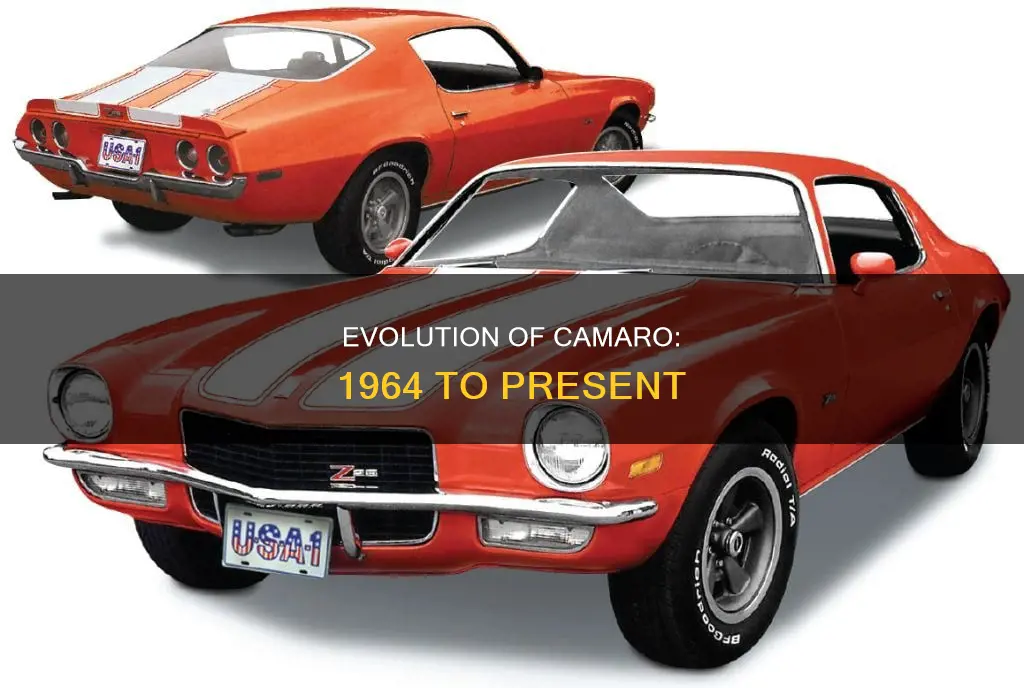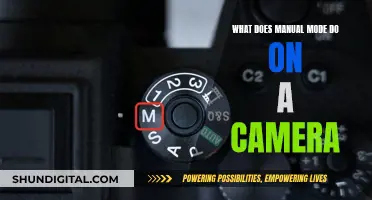
The Chevrolet Camaro is a mid-size American automobile manufactured by Chevrolet, classified as a pony car. It was first introduced in 1966 as a direct competitor to the Ford Mustang. Since its release, there have been six generations of Camaros, with the sixth generation Camaro being released in 2016. The Camaro has been discontinued twice in its history, first in 2002 and then again in 2024.
| Characteristics | Values |
|---|---|
| First Generation | 1967-1969 |
| Second Generation | 1970-1981 |
| Third Generation | 1982-1992 |
| Fourth Generation | 1993-2002 |
| Fifth Generation | 2010-2015 |
| Sixth Generation | 2016-2024 |
What You'll Learn

The first-generation Camaro was produced from 1967 to 1969
The first-generation Chevrolet Camaro was produced for the 1967 through 1969 model years. It was introduced in the fall of 1966 for the 1967 model year as a direct competitor to the Ford Mustang. The Camaro was initially known as the "F-car" and was born inside GM design studios under the leadership of Elliot M. "Pete" Estes in August 1964.
The Camaro was offered in coupe and convertible form, with a range of engine options, including inline-6 and V8 units. The base engine was a 230 cu in (3.8 L) inline-6, with larger engines available as options. The Camaro was built on a new rear-wheel-drive GM F-body platform, shared with the Pontiac Firebird, and was available as a 2-door, 2+2 seat, hardtop, and convertible.
The first-generation Camaro was available with a variety of factory and dealer options packages, but the three main offerings were the RS, SS, and Z/28 packages. The RS was an appearance package with hidden headlights, additional trim, and RS badging. The SS was a performance package, offering chassis upgrades and a choice of two V8 engines. The Z/28 was a high-performance package, initially unadvertised, offering a race-ready Camaro with a 290hp V8 engine.
From 1967 to 1969, a total of 701,138 Camaros were produced, with various options, interior colours, and trim levels. The Camaro's first-generation cars are highly sought-after collectibles, with a 1969 Chevrolet Camaro ZL1 COPO selling for $1,094,500 in January 2020. The average sales price of a first-generation Camaro is $61,340.
The first-generation Camaro was replaced by the Second Generation Camaro in 1970.
The Evolution of Sitcoms: 3-Camera Style, a Relic?
You may want to see also

The second-generation Camaro was produced from 1970 to 1981
The second-generation Chevrolet Camaro was produced from 1970 to 1981. It was introduced in the spring of 1970, with build information released to assembly plants in February of that year. This generation of Camaro was longer, lower, and wider than the first-generation Camaro, and was only offered as a two-door coupe body style, dropping the convertible option that was available for the first generation.
The second-generation Camaro featured a new body style with a fastback roofline and ventless full-door glass, without rear side quarter windows. The doors were made wider to allow easier access to the rear seat, and new pull-up handles replaced the old push-button handles. The roof was a new double-shell unit, providing improved rollover protection and noise reduction. The base model featured a separate bumper and grille design, while the Rally Sport option included a distinctive grille surrounded by flexible Endura material, with round parking lights and bumperettes. The rear featured four round taillights, similar to the Corvette.
The second-generation Camaro was an all-new car, but its basic mechanical layout was similar to its predecessor: a unibody with a front subframe, A-arm and coil spring front suspension, and rear leaf springs. The chassis and suspension were refined for both performance and comfort, with base models offering significant advances in sound-proofing, ride isolation, and road-holding. The second-generation Camaro was considered "a driver's car" by GM engineers.
The second-generation Camaro was initially offered with a range of engine and drivetrain components carried over from 1969, with some exceptions. The high-performance Z/28 option remained available through 1975, redesignated as the Z28 in 1972. The 1970 Camaro SS 396 featured a big-block 396 cu in (6.5 L) L78 engine rated at 350 hp (261 kW). The 1970 Camaro was also the first to be offered with a rear stabiliser bar.
The second-generation Camaro underwent major styling changes in 1974 and 1978, with the addition of federally mandated bumpers and a forward-sloping grille. The 1974 model was the last to have a flat rear window, with thick roof pillars. From 1975 onwards, a catalytic converter was added to the exhaust system of all US-market GM passenger cars, including the Camaro.
The second-generation Camaro continued to offer the base model, as well as the Rally Sport appearance package, the Super Sport performance package, and the Z28 Special Performance Package. However, these performance variants became less powerful and desirable as production continued, due to external factors such as fuel shortages, emissions regulations, and insurance increases. Despite this, the popularity of the Camaro grew, with sales topping all previous years in 1978, with 272,631 units sold.
The second-generation Camaro was replaced by the third-generation Camaro in 1981.
Understanding Your Camera's DPI and RAW Settings
You may want to see also

The third-generation Camaro was produced from 1982 to 1992
The third-generation Camaro was available in three models: the Sport Coupe, Berlinetta, and Z28. The base model, the Sport Coupe, came equipped with a 2.5 L four-cylinder engine, offering a more fuel-efficient option. The Berlinetta offered a more luxurious experience with its custom cloth interior, additional insulation, and full instrumentation. However, it was the Z28 that stole the show, featuring a powerful V8 engine and unique styling cues, including a distinctive nose and three-piece rear spoiler.
The third-generation Camaro also witnessed the introduction of the IROC-Z, an option package named after the International Race of Champions. The IROC-Z boasted an upgraded suspension, lowered ride height, and improved tires, enhancing its performance and handling. The IROC-Z proved so popular that it eventually became the standard on Z28s.
In 1987, a convertible Camaro was reintroduced, satisfying customers who longed for the open-top experience. This generation of Camaro also celebrated several milestones, including the 20th and 25th anniversaries of the model, commemorated with special edition packages.
Despite some initial criticism for its low power ratings, the third-generation Camaro left a lasting impact on the Camaro's legacy, with over 1.5 million units sold during this period. It represented the last decade when the Camaro was truly mainstream, and its unique blend of style, functionality, and performance continues to captivate enthusiasts even today.
Target's Camera Battery Options: What You Need to Know
You may want to see also

The fourth-generation Camaro was produced from 1993 to 2002
The fourth-generation Camaro was initially powered by a 3.4 L OHV V6 engine with a 5-speed manual transmission as standard. The 4-speed 4L60 automatic transmission was optional. In 1995, the 3800 Series II V6 engine was added as an option, giving buyers a choice between two V6 engines for the first time. The 3800 engine produced 200 hp and would eventually replace the 3.4 L V6 engine due to its more refined nature.
In 1998, the Camaro received a facelift and a new front clip, replacing the square inset headlights. The LT1 engine was replaced with the 5.7 L LS1 V8 engine, which was introduced a year earlier in the 1997 Corvette. The LS1 engine featured an aluminium cylinder block with iron sleeves, reducing weight by about 95 pounds compared to the iron block LT1 engine. The LS1 engine produced 350 hp at the flywheel but was marketed as 310 hp in the Camaro to avoid deterring sales from the Corvette.
The fourth-generation Camaro was known for its speed and strong engine options. The 2001 Camaro SS, for example, produced 325 horsepower and 350 pound-feet of torque. The 2002 Camaro Z28 SS could sprint from 0 to 60 mph in just 5.2 seconds. Despite their performance capabilities, the fourth-generation Camaros were not very fuel-efficient, delivering around 15 to 17 mpg in the city and 20 to 28 mpg on the highway.
The fourth-generation Camaro was also fun to drive and offered great handling. The lightweight cars were precise in steering and practical on all sorts of surfaces, except for snow. They required minimal maintenance and were built to be driven hard. Additionally, the 2002 Camaro, being the last year before the Camaro was discontinued for some time, came with a 35th-anniversary package that included features such as traction control and a Hurst short-throw shifter.
One of the cons of the fourth-generation Camaro was the limited interior space, with the back seats being uncomfortable for adults or taller individuals. The trunk space was also relatively small. Furthermore, some owners found it difficult to work on and maintain these vehicles.
Adobe Camera Raw 10: CS6 Compatibility Explored
You may want to see also

The fifth-generation Camaro was produced from 2010 to 2015
The fifth-generation Camaro was available in several trims and versions, including the V-6 and V-8 configurations. The V-6 engine was a 3.6-liter, direct-injected engine that produced an impressive 304 horsepower and 273 lb-ft of torque. The V-8 engine, on the other hand, was a 6.2-liter powerhouse that came in two variations: the L99, which produced 400 horsepower and 410 lb-ft of torque, and the LS3, which generated 426 hp and 420 lb-ft of torque.
The fifth-generation Camaro also offered a convertible option starting in 2011. Additionally, special editions were released during its production run, including the Transformers Special Edition, Synergy Special Edition, and the Indianapolis 500 Pace Car Special Edition.
The fifth-generation Camaro was well-received by the public, with sales averaging over 100,000 units per year. Its success can be attributed to its retro looks, advanced technology, and exceptional power, making it one of the fastest eras of Chevrolet's Mustang-mauler.
Mastering Camera Raw Cache: Tips to Control Size
You may want to see also
Frequently asked questions
There have been six generations of Camaro since 1964.
Chevrolet sold 220,917 Camaros in the first year.
The most popular Camaro was the 1979 Camaro, with over 282,000 of them produced that year.
The 2020 Hennessey Resurrection is the most powerful Camaro made to date, with 1,200 horsepower.
The Camaro SS stands for Super Sport and is a performance package a buyer can purchase for their Camaro.







